Once your baby is close to one year of age, they reach a significant milestone… WALKING. Babies can’t achieve the ability to walk in a week’s time.
They go through different phases, like sitting, standing, and walking with support, before they learn to walk completely independently.
There are several products on the market available that support and help babies to learn to walk.
Baby walkers and baby jumpers are two popular items that provide the necessary support for the baby to walk. But what exactly are walkers and jumpers?
Are they the same thing? Or is one significantly better than the other?
Baby walkers and jumpers are two different types of baby equipment that can be used to help babies develop their motor skills and exercise. One main difference between the two is that baby walkers allow babies to move around a room by pushing themselves with their legs, while baby jumpers are completely stationary and allow babies to jump, bounce, and hop in place.
Let’s get into the nitty-gritty to see exactly which product is best for you and your baby…
What Is A Baby Jumper?
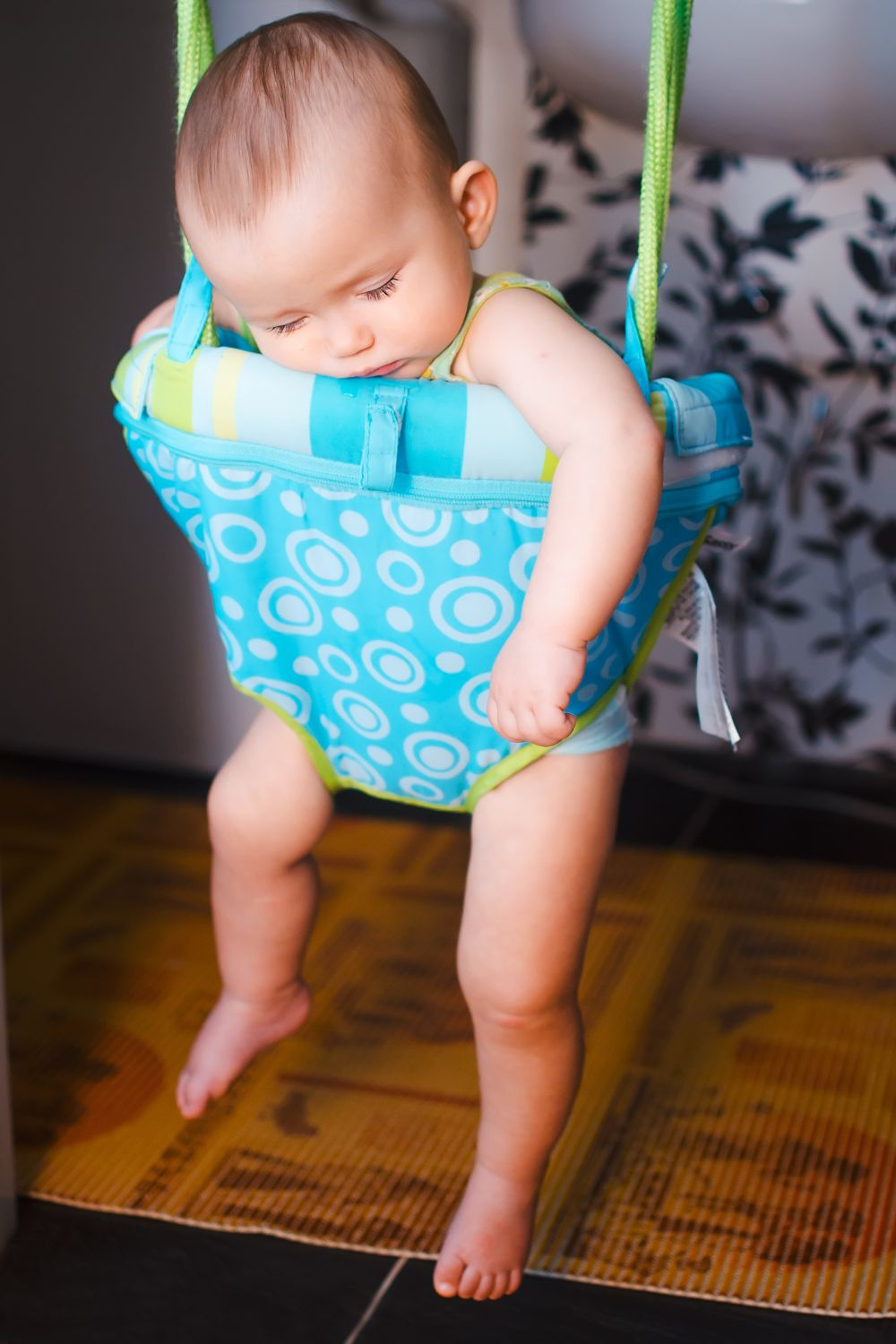
A baby jumper, otherwise called an exercise jumper, jolly jumper, or baby bouncer, is a sling seat attached to a spring or elastic.
The seat has two leg holes through which you can hang the baby’s leg. The baby can sit on the seat and bounce by touching the toe on the floor.
You can use a baby jumper once the baby has developed head and neck control. Most babies get full control of the neck and head once they are 5-6 months of age.
You can start using the baby jumper from 5-6 months, given your baby has full control of their neck and head already. Consult your doctor to double-check if your baby is ready for this milestone.
Most baby jumpers will have a maximum recommended weight of around 25 pounds. Once your baby crosses this weight, it is best not to use the baby jumper anymore, for safety reasons.
Pssst… We recommend THIS Jumper!
What Are The Different Types Of Baby Jumpers?
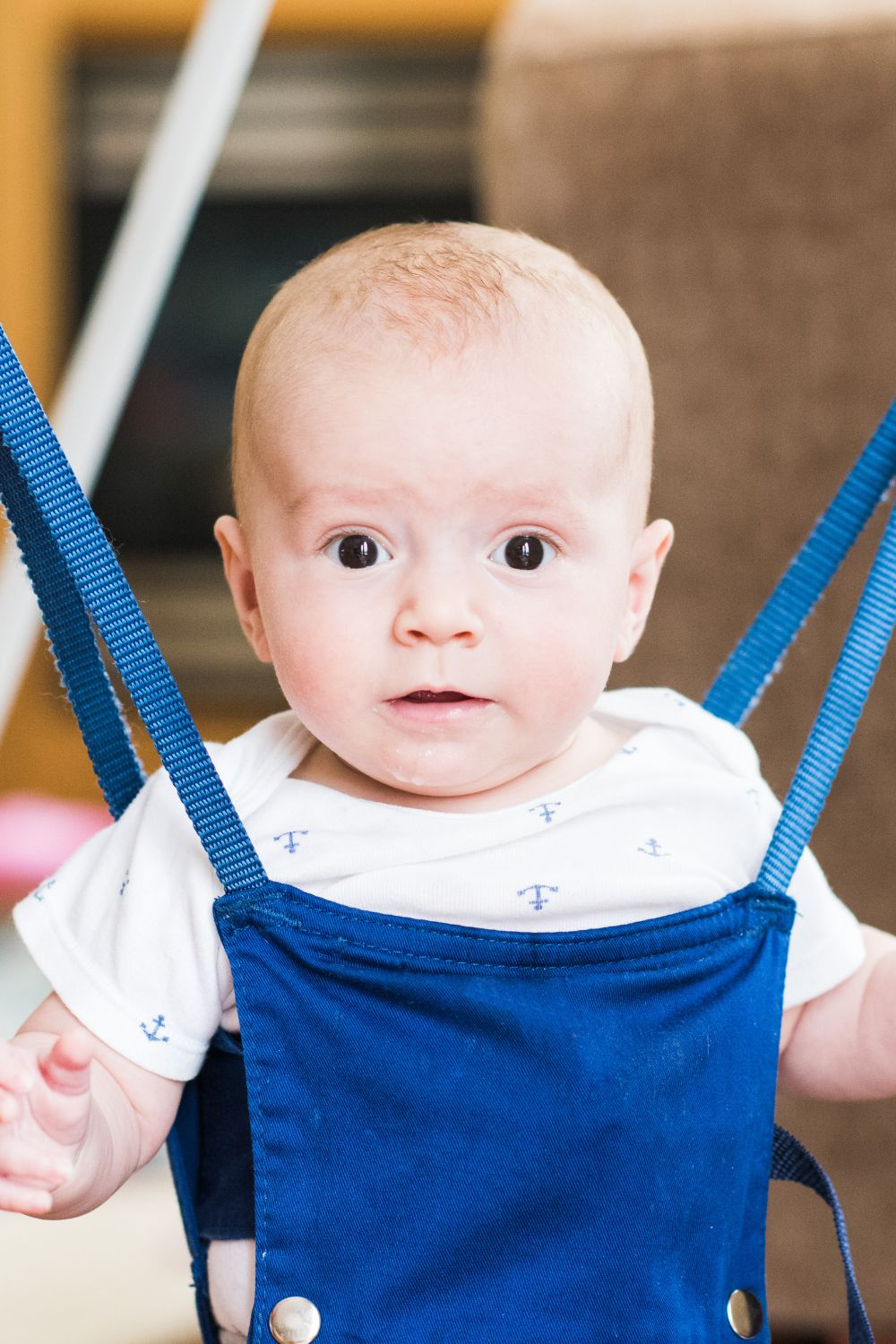
There are three types of jumpers available in the market currently.
Doorway Jumpers
The doorway jumper has a fabric seat, an elastic band and a clamp for attaching to the frame of a doorway. The main advantage of the doorway jumper is that it occupies very little room.
However, you cannot install it in all door frames. The frame should have the provision to attach the clamp.
Doorway jumpers are lightweight and portable, perfect for moving from place to place.
These take up very little space are easy to store, making them perfect for smaller homes or apartments.
However, these jumpers can only be used in doorways that can fully support the weight of the baby and jumper. Plus, they must have a clamp that securely attaches.
If you are unsure if your jumper is securely placed or if your doorway is sturdy enough, it’s best to go for a stationary or activity jumper.
Stationary Jumper
This type of jumper comes with a metal frame. The baby seat and the elastic band are attached to the metal frame. The whole structure becomes an independent unit. You can move the jumper wherever you want.
One of the biggest advantages of a stationary jumper is that it can be placed in a specific location in your home an left there, allowing for easy access for you and your child.
This is very convenient if you have limited space or don’t want to deal with the hassle of constantly setting up the bouncer and taking it down.
On top of this, one of the main selling points of a stationary jumper is that they are studied and more stable than the frames found in portable bouncers. This extra stability and security for your baby is priceless.
Activity Jumper
The activity jumper is similar to a stationary jumper. This jumper will have a separate tray fixed on the front with various colorful activities. This helps keep the baby engaged for a long.
Since the activity tray is typically filled with various toys, this helps the baby stay engaged for a long time.
The colorful buttons, mirrors, shapes, and other interactive items stimulate the babies senses and keep them occupied.
The goal of activity jumpers is to provide babys with a safe and secure place to play and exercise, while also helping them develop their coordination and gross motor skills.
Many parents have found that the bouncy motion of the jumper and the interactive toys combined keep their babies entertained for longer periods of time (vs. other jumpers.)
What Are The Pro’s and Con’s Of A Baby Jumper?
Pros of a Baby Jumper
Keeps The Baby Entertained
Keeping the baby entertained all the time is a difficult (ahem, impossible) task. A baby jumper does the job of entertaining the baby by enabling them to bounce and burn off some energy.
Plus, some jumpers have colorful toys attached that can help entertain the baby and provide stimulating actiivities. This provides much-needed free time for the parents.
And most babies love the bouncing motion of the jumper, which captures their attention even further.
Of course, it’s important to always supervise your baby while they’re in the jumper, but they provide a safe and secure place for your baby to play and exercise while you can do other things.
New moms know how overwhelming things can get, so this allows some much needed time to relax and recharge.
Burns Off Energy
Keeping the baby physically active all the time is a tough job. The baby jumper helps the baby bounce and jump, helping channel all that energy into physical activity. This helps the baby to sleep well.
Getting more physical activity throughout the day can help the baby sleep better at night.
Beyond just sleeping better, regular physical activity can have numerous benefits for a baby’s development. Everything from improving their strength, coordination, and even balance to stimulating their senses and promote healthy brain development.
Plus, it’s a fun form of physical activity that the baby will actually enjoy.
Safety
Once the baby is placed inside the jumper, they stay safe. The baby cannot get out of the jumper on its own.
Parents can safely leave the baby in the jumper without worrying about the baby falling or hurting themselves.
Plus, since the jumper is stationary, there is no danger of them moving around and getting hurt.
The baby is securely seated in the jumper and this prevents them from falling out or getting hurt.
Regardless of the safety component though, it’s always important to supervise your baby when they are in the jumper. Stationary jumpers are very safe but they are no substitute for adult supervision.
It’s also important to make sure the baby jumper s always set up an assembled properly so the baby is seated securely in the seat before use.
Easy To Carry Around
Baby jumpers are lightweight and portable. You can easily carry it with you while traveling. This is useful for parents who want to keep their baby entertained while on the go.
They are also easy to clean as baby jumpers are made of fabric. They typically have removable seat pads and the fabric cover can be machine-washed.
Cons of a Baby Jumper
Developmental Problems
The position in which the baby sits on a jumper can cause a lot of strain on the hip. If the baby is made to sit in the jumper for too long, it can cause developmental hip disorders or muscle tightness in babies.
Always follow the manufacturer’s guidelines for use and pay close attention to your baby’s body language while in the jumper.
As a general recommendation, you should not make the baby sit for more than 15-20 minutes at a time.
When babies are seated on the jumper, they will most likely lean forward. This can cause tightness of the calf muscles. The gluteus muscles, on the other hand, do not get enough exercise.
n order to prevent muscle tightness and promote healthy development, it’s recommended to vary a baby’s activities.
Switching the baby between jumpers, tummy time, crawling, and walking is the best way to make sure all muscles are worked, and there are no developmental problems.
Cause Injury
Even the best baby jumpers need to be properly assembled, and the baby needs to be supervised while on it.
Although they do offer a high degree of safety, there are always some potential risks that parents and caretakers must be aware of.
If properly assembled, a baby will not fall from the jumper and get injured. But if the jumper is fixed to the door frame, there is the danger of the baby hitting the frame while bouncing. This can happen if the baby bounces too high as well.
To help prevent this type of injury, make sure the jumper is properly assembled and the baby is securely seated every time.
Also, always make sure the baby has enough space and there are no objects nearby while they bounce.
Another factor are older siblings. Older siblings can sometimes push the baby from the jumper resulting in injury. Older siblings can be playing or roughhousing in a way that could potentially hurt the baby.
Supervising them during playtime is important to make sure both are safe and there are no risks.
There is also the chance of injury caused by mechanical failure. Always follow the manufacturer’s guidelines and regularly check the jumper for signs of wear and tear.
If the jumper seems damaged or not functioning properly, it should be immediately replaced or repaired.
Can Lead To ‘Toe Walking’
When babies are placed in a jumper, they point their toes down in order to push off the ground and bounce. This can lead to changes in muscle tone and strength, causing a potential change in their gait and walking patterns.
If a baby spends too much time in a jumper, it can lead to muscle imbalances and foot deformities down the road.
Even when the baby is taken out of the jumper, there is a chance that they might walk on the toe. This happens because the jumper uses the front muscles of the leg (quads and shins), while the back of the legs (hamstrings and calves) aren’t getting any exercise.
This can lead to ‘toe walking,’ where a baby is more comfortable walking on their toes than the balls of their feet.
It’s important to limit the amount of time a baby spends in a jumper to prevent these types of imbalances. Including a variety of activities in their day to stretch and strengthen different muscle groups is important.
What To Consider When Using A Baby Jumper
Baby jumpers are a fun way to help your baby burn off some excess energy and sleep better at night. On top of that, some have a toy tray that provide games and stimulation, giving parents a breather for a couple of minutes.
With that said, there are some important things to keep in mind when purchasing and using a baby jumper to make sure it’s a fun and safe experience:
- Always purchase jumpers of good quality from well-known brands. You should assemble it properly as per the manufacturer’s instructions.
- Periodically check for any damages in the jumper, like worn-out straps.
- Never leave the baby unattended while in the jumper. Also, make sure that the baby is securely strapped to prevent accidents.
- Do not make the baby sit in the jumper for more than 15-20 minutes at a time.
- You should keep the floor below the jumper clean so that the baby can jump comfortably.
- The baby jumper has a specified weight and height limit. You should stop using the jumper once the baby exceeds the height and weight.
- If you use a doorway jumper, ensure the door frame is strong enough to hold the clamp. Otherwise, the clamp will come off and can cause injury to the baby.
What Is A Baby Walker?
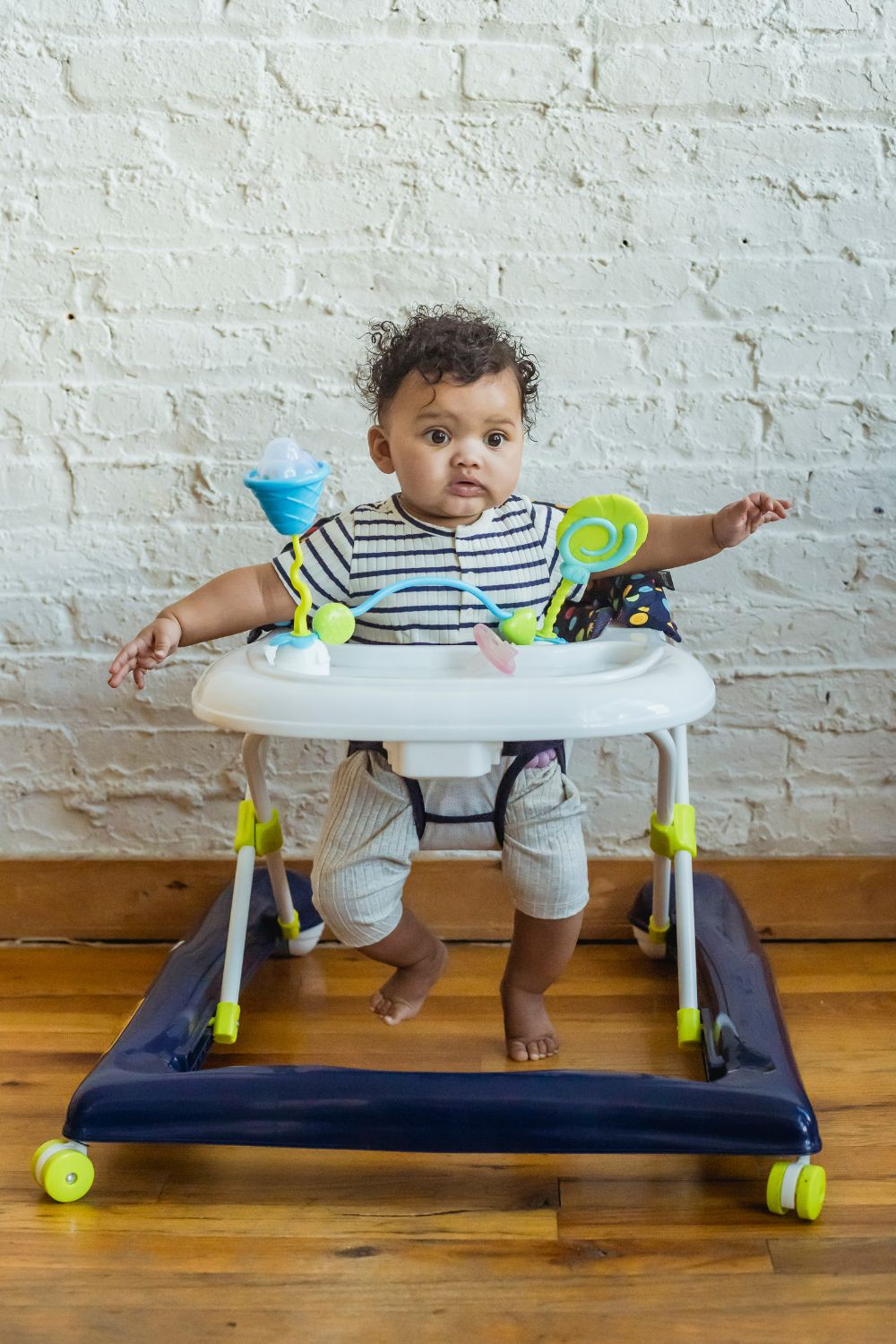
A baby walker is a device that, you guessed it, helps the baby learn to walk. It has a circular frame from which a fabric seat with two holes is suspended. The frame is made of plastic and provides good support for the baby while walking.
Baby walkers can be very helpful as they provide a sense of stability and support while the baby is learning to move around on their own.
Some walkers even come with a small table or space where you can keep the baby’s toys. Some even come with in-built toys for the baby to play with.
There is another type of baby walker called the push walker. This walker has a plastic frame with wheels and a handle on top. The baby can hold the handle and walk around.
The plastic frame usually comes with colorful toys attached to it to make it more attractive. In addition to plastic, you will also find push walkers with wooden frames.
Baby walkers are designed for babies who can hold their heads without support and touch their legs on the floor. It is ideal for babies from 8-9 months of age.
Pssst… We recommend THIS Walker!
What Are The Pros And Cons Of A Baby Walker?
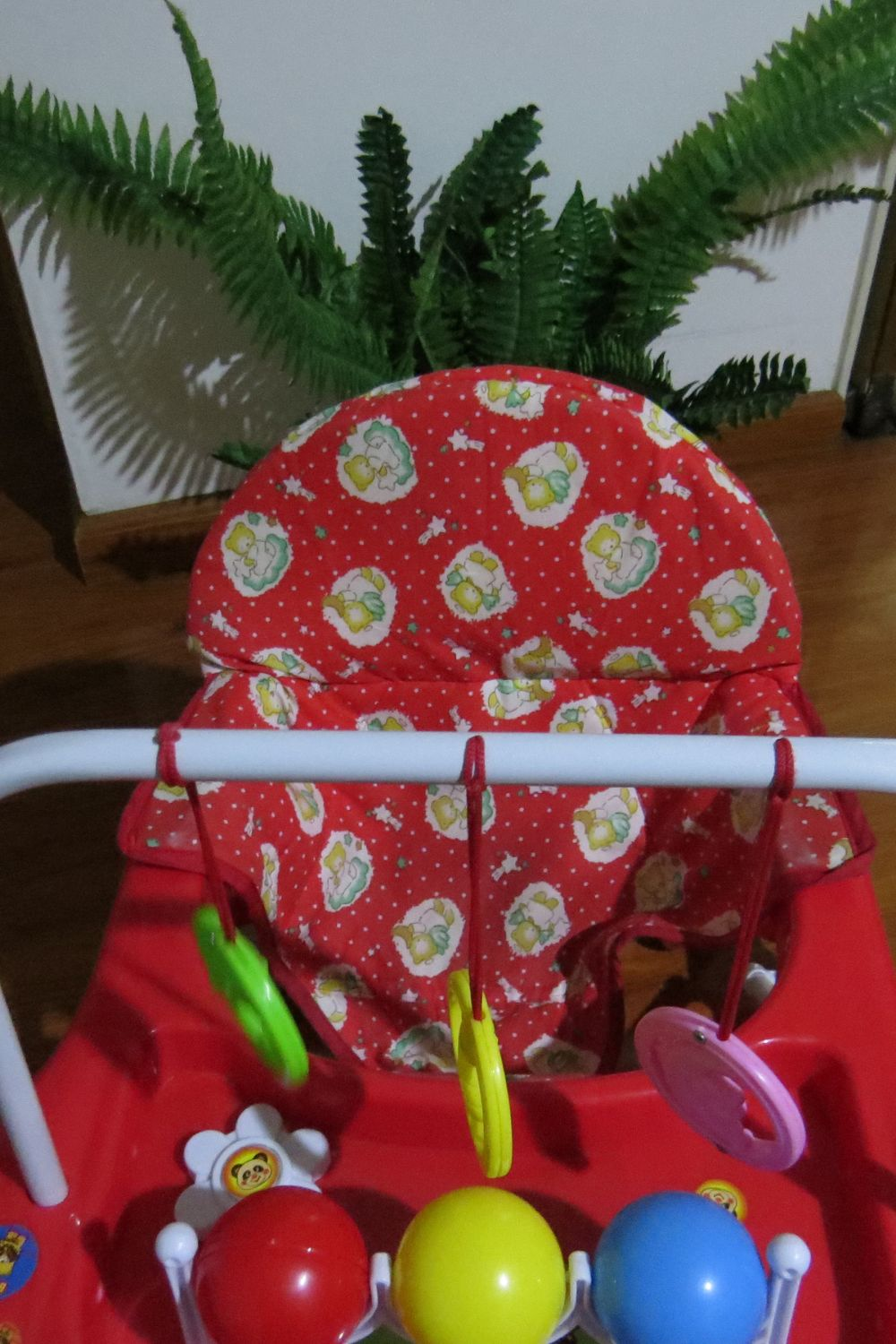
Pros of Baby Walkers
Helps Baby Walk
The baby walker helps the baby learn to walk. It provides the much-needed mobility for the baby to move around and explore things.
Babies can have their first taste of independence and freedom as they can move around and explore their surroundings.
The wheels on the walker allow the baby to move around easily and the frame provides the necessary support and stability. This also allows baby’s to improve their balance and coordination.
Keep The Baby Engaged
Since the baby can move around freely, it keeps them busy and engaged. This provides more time for the parents to attend to their personal things.
Whether it is cooking, cleaning or any other household chores, parents are assured that the baby is safe in the walker. A baby in a walker is normally happy as they can do things they previously couldn’t.
Of course, even though the walker keeps a baby entertained, they shouldn’t be left unsupervised, as they can always get into mischief if unattended.
Mentally Stimulating
Most baby walkers have attached toys and different shapes, colors, and sounds fixed to the front rack. While using the walker, babies get plenty of time to explore these colorful and varied toys and play with them.
The different colors and sounds made by these toys are mentally stimulating for babies.
Some baby walkers make sounds when touched or have lghts and mirrors that grab a baby’s attention. These types of toys encourage your baby to engage with their environment while stimulating their senses.
On top of this, these types of toys support a baby’s cognitive development. They will slowly learn about cause and effect, allowing them to understand the relationship between objects and actions.
Cons Of Baby Walkers
However, just like a baby jumper, a baby walker also has various disadvantages that we have to be aware of.
No Proper Strengthening Of Muscles
All muscles of the baby’s legs that are required for walking are not strengthened while using a walker. This can affect the normal development of the baby.
A baby should hold things and stand before they learn to walk. This is not possible while using a walker. Walking using a baby walker is artificial and not actually ‘walking’ as they are seated and supported by the frame.
Since they are fully supported by the walker and not using their own leg muscles, this can lead to a lack of muscle strengthening in the legs.
Babies should be given the opportunity to stand and hold objects before they start walking. These first steps help develop the muscle strength and coordination.
As a baby can’t practice these activities when in a walker, it’s important to make sure they are still doing them outside of the walker. Thsi well allow the baby to strengthen their muscles and not cause any developmental issues down the road.
Easy Reach Of Undesirable Items
The baby can now move freely and quickly while using a walker. Those items that were once out of reach are now easily accessible by a baby on a walker.
Once a baby is in a walker, more steps need to be taken to make sure the house is baby-proof. Making sure all items that are not desirable for the baby at a higher level or storing them in cabinets.
Keep hazardous items, like the handles of pots and pans, far away from arm’s reach.
You’ll also need to install more safety devices, such as outlet covers, cabinet locks, and door locks.
Higher Chances Of An Accident
A walker with wheels can sometimes go uncontrollably, as the baby doesn’t have full control or strength to stop it at times. The walker may go in an unintended direction or move too quickly.
The child can run into objects or fall down when this occurs. This can happen quickly, and parents may not be able to respond fast enough in these scenarios making the likelihood of an accident higher when using a walker.
Choosing a walker with good stability and sturdy construction is your best bet to avoid these types of accidents.
False Sense Of Security
A baby walker creates a false sense of security as it can seem like the child is safe and can’t move around too much.
Parents may sometimes leave the baby unsupervised in a walker for a short period of time, as it is considered safe. This may lead to less than favorable situations.
It’s important for parents to realize that a baby walker doesn’t provide a completely safe environment for a child. As with all baby gear, there are potential hazards, and adult supervision is always required.
As long as caregivers understand that a baby walker doesn’t eliminate the need for supervision, it is a great addition to any household.
Lack Of Natural Balance
Babies do not learn to balance themselves while using a walker. Even if the baby moves sideways or forward, the walker prevents the baby from falling.
The walker supports the baby’s weight while walking, which is not the case with normal walking. The baby does not develop the natural balance while using a walker as the walker provides full support.
Regular walking requires the child to use their balance and coordination to stay upright and move around. Not practicing can prevent the child from developing these important skills.
A baby walker should be supplementary and children should have time to develop their balance and coordination outside of the walker.
Delay Other Developments
Normally, parents use the walker around the same time the baby is crawling. When the baby is made to sit in a walker, the chances of crawling are reduced. In this situation, crawling and walking can be unduly delayed.
Babies normally start to crawl around 6 to 9 months, and this is a major milestone. Crawling helps babies develop their physical skills like strength, coordination, and balance.
A baby will need these skills when they start walking later on.
But if the baby is constantly placed in the walker, there will be little opportunity to crawl around. The baby will be n the walker and not need to use their physical strength and coordination.
And in turn, if they don’t develop this strength through crawling, depend walking (outside of the walker) can be delayed as well.
What To Consider When Using A Baby Walker?

Baby walkers are a great way to allow babies a sense of freedom and independence. They’re mentally stimulating, and most babies thoroughly enjoy using their walkers.
With that said, there are some important things to keep in mind when purchasing and using a baby walker to make sure it’s a fun and safe experience:
- The walker should be sturdy and have a good base. It should not topple easily, causing injury to the baby. The wheels of the walker should have a break system.
- You should always use a baby walker on a flat surface without any barrier. This ensures that the walker moves freely without any disruption.
- The baby walker should be used in places away from the staircase as there is the danger of falling down. Similarly, it would be best if you did not use it near the pool for the same reason. Before using a baby walker, you should always install safety gates in potentially dangerous areas.
- It is best for an adult to be around while using a baby walker. This prevents possible accidents.
- Baby walker increases the mobility of the baby. Thus, you should keep all sharp and dangerous items away from the baby’s reach. You should keep hot drinks, electrical chords, and cleaning products away from the easy reach of the baby.
Baby Jumper Vs. Baby Walker
Whether to go for a baby jumper or baby walker is purely a personal choice. Both gadgets can be used once the baby has neck and head control and can keep the legs low.
Since a walker is kept on the floor, the baby’s legs touch the floor. This can help in future walking. A walker provides more freedom for the baby as they can move around and explore things.
In the case of a jumper, the legs touch the floor only for a while as the baby bounces and jumps. A jumper is purely for entertainment purposes.
Since the jumper is stationary, the baby cannot move around and explore the place. Babies are likely to feel bored after some time as the jumper is stationary.
Both are useful and serve different purposes. It’s not a fair comparison as they are both great additions nd offer fun features. An active baby will enjoy both the jumper and walker in different phases of their life.
What’s The Difference Between A Walker And A Jumper
The main difference between a baby walker and a baby jumper is that while a walker lets the baby move around, a jumper is stationary.
While being seated in a baby walker, the baby has great mobility. They can move around and explore new things. This is both beneficial and dangerous for the baby.
While the baby gets to touch and feel new things on its own, it can be dangerous if unsafe things are kept nearby. Thus, you should baby-proof the house before letting the baby use a walker.
A baby jumper is a stationery gadget. The baby can jump, bounce and hop while being seated in a jumper. It cannot move around. As a result, the baby can feel bored after some time while being in a jumper.
Is A Walker Or Jumper Better For The Baby?
We recommend jumpers over walkers for short periods of time. They provide entertainment and the fact that they are stationary makes them safer than a walker.
However, both are great options under adult supervision and for short periods of time.
A baby shouldn’t be in a walker or jumper long-term as they can interfere with normal development. A baby needs first to sit, pull up while holding furniture (or other hard surfaces,) and slowly learn to walk. This helps develop all the muscles in the baby’s leg.
When the baby is made to sit in a walker or jumper for long periods of time, leg muscles do not get the proper exercise. Since only the toe touches the floor, it can interfere with normal walking.
If the baby is made to sit in a walker or jumper, the baby spends less time on the knees, crawling. Crawling is very important to develop the pelvis and shoulders.
So although we like walkers over jumpers, neither should be used for long periods of time. A 15 to 20-minute session in a jumper or walker is enough.
And always make sure your baby gets plenty of tummy time, crawling, and other activities outside of the jumper/walker.
Conclusion
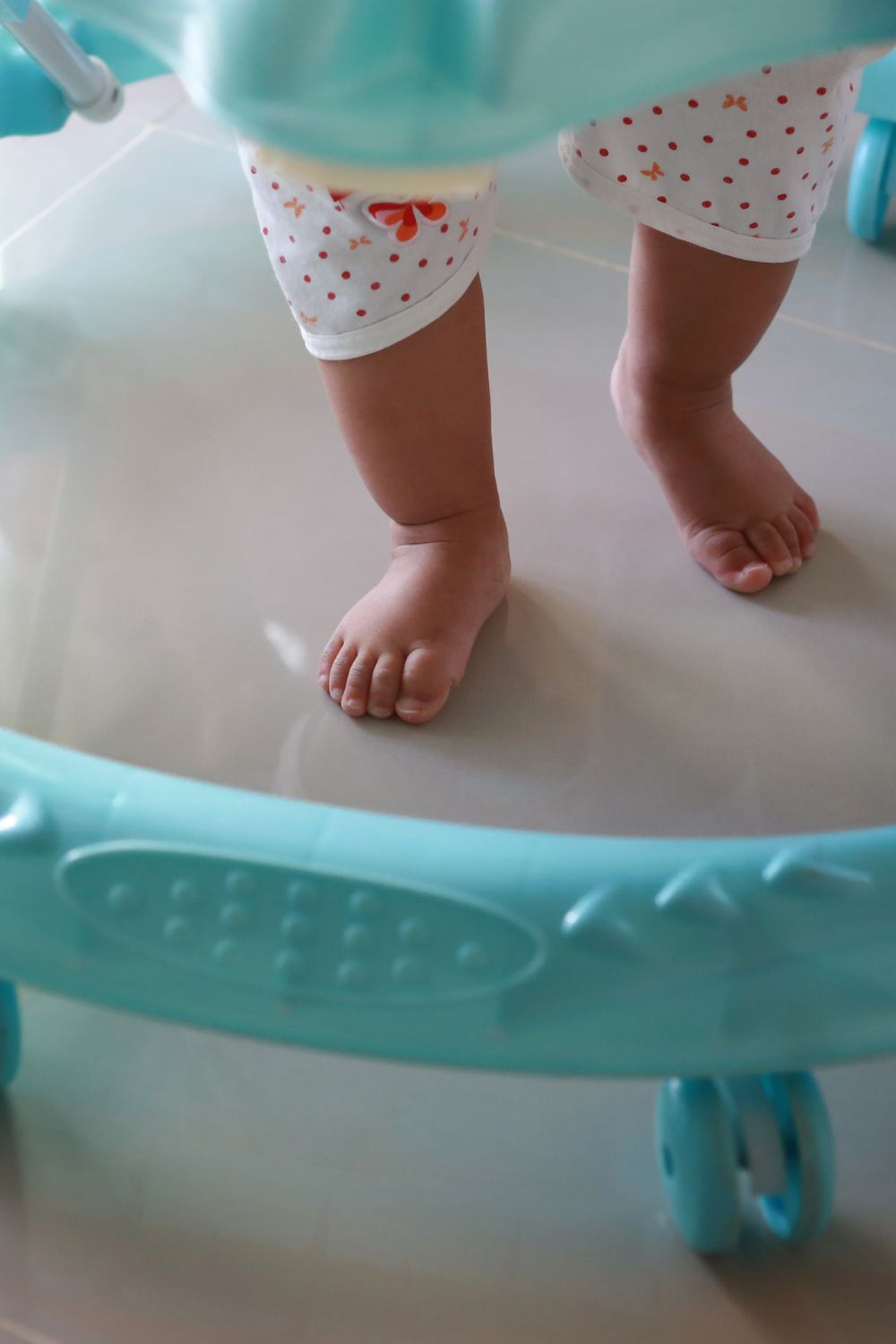
Whether to go for a baby jumper or a baby walker is a debatable question, as both have their advantages and disadvantages.
To keep the baby entertained and provide some free time for parents, you can place the baby in either for 15-20 minutes. This way, you keep the baby entertained while not causing harm to their delicate muscles and development.
FAQ’s
A baby walker supports the baby in walking. But it does not provide proper strength to the leg muscles for walking.
Meaning a baby using a walker isn’t really ‘walking.’ Using the item regularly can delay the developmental milestones of the baby.
Baby jumpers are ideal for entertainment purposes. The bouncing and hoping of the baby jumper can keep the baby amused.
However, using the baby jumper for a long period of time is not appropriate. At the most, you can use it for 15- 20 minutes twice a day.
The neck and head muscles should be strong enough for a baby to use a walker and a jumper.
The baby should also be able to pull the legs down. Normally this happens around 5-6 months of age. Thus, a baby can use a jumper from 6 months and a walker from 8-9 months.
You can use a push toy instead of a walker. While using a push toy, the muscles of both legs are used. A push toy actually helps in normal walking.
However, you should closely monitor the baby while using a push toy to prevent accidents.
The baby walker comes with a circular frame with a fabric seat inside. The design of the walker is provides full support to the baby.
The chances of the baby toppling and falling are unlikely while using a walker.